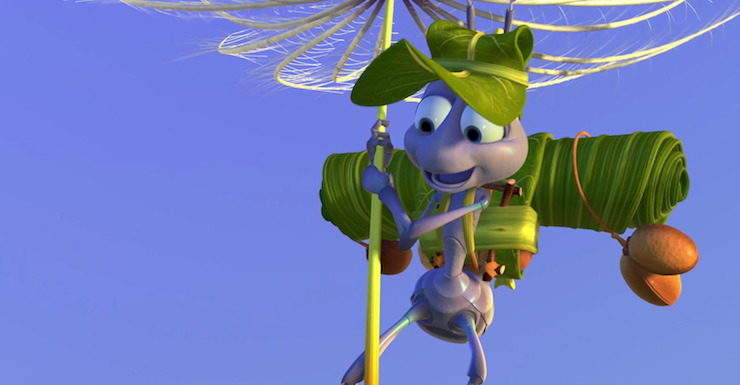In its initial release, A Bug’s Life had the dubious fortune of getting released in a year with not one, but two computer animated films about bugs, a deliberately created rivalry that did neither film any favors. Since then, A Bug’s Life has had the dubious honor of being perhaps the least remembered of the Pixar films, and perhaps the least regarded—depending upon how you feel about the various Cars films and, more recently, The Good Dinosaur—rarely if ever listed among the Pixar “greats.” At the time, however, it was proof that just maybe Pixar could be more than a one film wonder.
Pixar’s original deal with Disney had been for three movies. Nonetheless, the technical and story challenges with Toy Story had been so great that rather than follow Disney’s policy of having at least two, and occasionally three or four, films in development at the same time, allowing for one film per year—a habit immediately installed by new rival DreamWorks—Pixar animators devoted nearly all of their attention to Toy Story until that film’s script and story issues were ironed out. Only in 1994—three years after the three film deal had been signed, and when Toy Story had a set release date for 1995—did Pixar animators and directors start the process of tossing out new ideas.
The filmmakers were united on one thing: the new film needed to avoid depicting humans, if at all possible, or at least limiting the depiction of humans, if at all possible. Trying to replicate the look of human skin and movement had been one of the most difficult technical problems with Toy Story, and one which had not been entirely solved. Instead, the Pixar directors thought, they could focus on things like monsters. Or fish. Or bugs. The monsters, however, might have to interact with humans. And the fish would have to swim in water—something not yet tried in computer animation. Bugs, though, could make use of the techniques already developed for Toy Story—individual blades of grass and leaves, for instance. And a bug film could presumably allow the filmmakers to replicate many of the various perspective and other in jokes that were working so well for Toy Story.
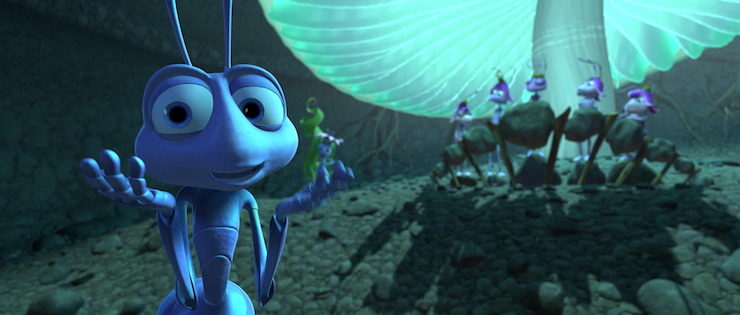
On that basis, the monster and fish films were temporarily shelved—something that several scenes from A Bug’s Life would prove to be the correct decision on a technical level, particularly for the fish film. Instead, John Lasseter, Andrew Stanton, Pete Docter and Joe Ranft continued to tinker with the bug story for another year before pitching it to Michael Eisner in 1995. Eisner liked the concept, and agreed that A Bug’s Life could be the second Pixar film. The concept still lacked a script, however, and since everyone at Pixar was frantically trying to complete Toy Story’s finishing touches and last minute changes before its November release, the bug film, too, was temporarily shelved—to the point where even after Toy Story’s release, Pixar animators found themselves heading back to work on commercials instead of feature films. And—occasionally—speaking to Jeffrey Katzenberg, just to toss ideas at him.
By this time, Jeffrey Katzenberg, who had helped guide not just the Disney Renaissance, but the original Disney/Pixar deal, had left Disney after a major fight with Michael Eisner, setting up his own company, DreamWorks, with Stephen Spielberg and David Geffen. He remained, however, on friendly terms with Lasseter, who admired Katzenberg and liked to toss ideas around with him. Including—at least according to Lasseter—some ideas about animated bugs, and more specifically, the plan to create a film about animated bugs for Disney. In what could be called an “interesting coincidence,” at some point after this chat, Katzenberg put an animated bug film of his own, Antz, into production in May 1996. An infuriated Steve Jobs and John Lasseter, who had not been part of the Katzenberg/Eisner feud, accused Katzenberg of stealing their idea for a bug picture.
It is only fair to note that Katzenberg, in turn, noted that he’d first heard a pitch for a bug film back in 1991 (some sources claim this pitch was actually made in 1989 or 1994) and that his decision to release Antz shortly before A Bug’s Life (which in turn, was scheduled for release at about the same time as DreamWorks’ The Prince of Egypt) had absolutely nothing—nothing—to do with his fight with Michael Eisner or the tiny fact that Disney had failed to pay him his contract bonus. Steve Jobs was completely unconvinced, and headed to the media. Other Disney executives attempted to pretend that the feud wasn’t even happening, but the rival bug films kept the media buzzing for a bit, and allegedly did not do much to improve corporate morale.

Internally, Pixar was dealing with another issue entirely: resentment towards how Pixar’s initial 1995 public stock offering had been handled, greatly in favor of just a very few Pixar executives that Disney had demanded sign long term employment contracts, leaving other long term Pixar employees—including many animators who had toiled endlessly over Toy Story—out of the investment bonanza.
The combined internal resentment and external irritation and concern about the rival bug films meant that film production was considerably tenser than it had been during Toy Story. Disney’s decision to order a direct-to-video sequel to Toy Story while A Bug’s Life was still in production and while the company was still churning out a few additional television commercials (contracted after the release of Toy Story, but before the script for A Bug’s Life had been finalized) was another burden on an animation studio which, until this point, had only needed to focus on one production.
Some of this tension may have found its way into two sideplots of the film, particularly in scenes of grasshoppers complaining about their exploitation of the ants, only to face the wrath of their supervisor, and between the hard working but underpaid circus bugs and their temperamental manager, who abandons them for days, returning only after his realization that they can, indeed, make money for him, and who later ruins their major production by setting it on fire.
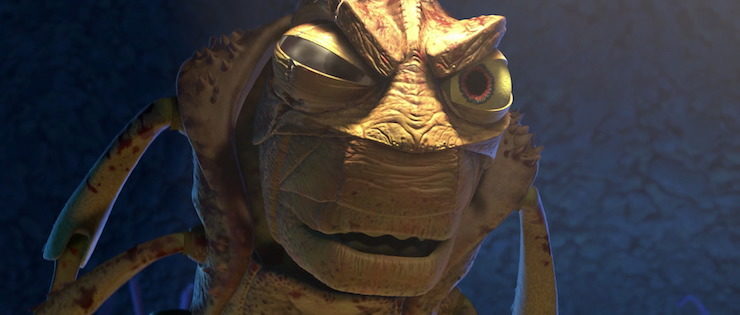
The studio also struggled with three other technical issues: namely, how to make bugs look cute and friendly and cuddly instead of like, well, bugs, and how to animate large numbers of ants (enough to mimic an ant colony), and how to get their computer systems to handle the more complex models required by this film. The final problem ended up being “solved” in a way all too familiar to many computer users even now; just accepting that the modeling process would often be sluggish. But for the film to work, the bugs had to be cute and friendly and cuddly, and an ant colony had to have lots of ants.
Cute and friendly bugs proved difficult for two different reasons. For one, these were, after all, bugs, and for two, the Pixar rendering systems were still not capable of creating “soft” looking, variant textures, but only hard, shiny, plastic like surfaces. In many ways, that plasticity was ideal for portraying the often smooth exoskeleton of ants—but unfortunately, the more the ants looked like ants, the less friendly (to humans and small children) they seemed. The usual cartoon touch of just creating bigger eyes, often associated with “cuteness” (what Disney had done, well back in the day, to make Mickey Mouse look “cuter” and more approachable) also tended to backfire, since large eyed ants on a huge movie screen looked, well, like rather terrifying giant ants with unusually large and scary eyes.
Stuck on both the eye and surface rendering problem, the animators tried a different approach: making the ants more human looking. Instead of the standard six ant legs, for instance, the ants in A Bug’s Life have two legs and two arms—and fingers and toes. Even more importantly, they walk—or scurry—upright—making them look a little more like humans dressed in bug costumes than actual bugs. For the circus bugs, the animators tried to focus on “friendlier” insects—a ladybug, a plump caterpillar, a gypsy moth, a delicate praying mantis—but then added a black widow spider, kinda defeating the purpose there.
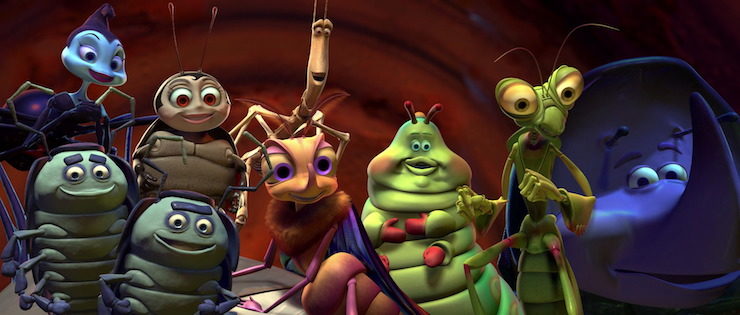
And to keep the insects as lighthearted and friendly sounding as possible, the producers decided to stick, for the most part, with well-known comedy actors: with one major exception: Kevin Spacey, who had admired Toy Story and other Disney films, and was more than willing to voice a very mean bug. This focus on comedians had the later adverse effect of making me feel that really, the best thing the ants could do was immediately remove Princess Atta, voiced by Julia Louis-Dreyfus, from her current role as second in command, and nod in emphatic agreement whenever she expressed doubts about her ability to lead the ants—but the directors could not possibly have foreseen either Veep or Selina Meyer… Otherwise, the voicing is decent to excellent, with the arguable exception of Dave Foley, who rather fades into the voice of major ant Flik, not really doing much with it.
Though to be fair, that probably has more to do with Flik than with Dave Foley, or, more specifically, the writing for Flik and the other characters, which tends to be superficial at best. Which leads to A Bug’s Life’s biggest problem: too many characters, and too many character journeys. No less than three characters—Flik, Princess Atta, and Dot—all go through some sort of major self-doubt/heroic journey, and A Bug’s Life also tries to give three of the circus bugs and one of the grasshoppers a touch of character development as well. The end result: no one gets much character development or depth at all.
The second result: a film that despite its relatively short length, meanders, and meanders, and meanders. The basic plot is simple: the grasshoppers have been terrorizing an ant colony for years, and after a well-intentioned Flik manages to topple over the ants’ annual offering, infuriating the grasshoppers, the ants happily send Flik off to go find help, so that they can collect the replacement offering in peace, without worrying that Flik will knock it over again. Off Flik goes, with a little flying bit that makes no sense if you’ve ever watched ants crawl up and down walls, but moving on, eventually encountering a group of circus bugs. The naïve Flik believes that the circus bugs are genuine heroes; the circus bugs believe that Flik is a genuine talent agent. Hilarity ensues, but not quickly.
The final confrontation between the ants, the grasshoppers and the circus bugs definitely has its amusing moments and spectacular animated effects, and a chance for nearly everyone to shine—but creates questions. Many questions. Mostly, why do the ants and circus bugs feel the need to come up with such an elaborate, dangerous, labor intensive plan that could lead to everyone’s downfall—a plan that does end up setting a good part of the area on fire? Why go to the effort of creating a fake bird? I mean, they have a black widow spider standing right there. Surely she could just weave some webs and toss some venom around?
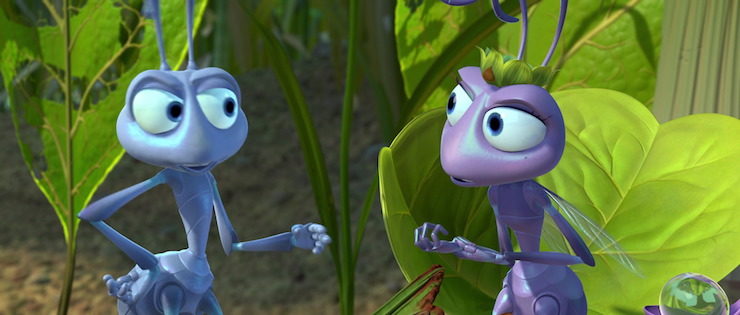
I’m also unconvinced by the romance between Flik and the princess. Sure, Flik has apparently adored her for years, and understands her self-doubts. And sure, Flik—eventually—is responsible for freeing the ant colony from grasshopper oppression, and gratitude has been known to lead to other emotions. But against this, they don’t exactly meet as strangers: the early scenes clarify that Princess Atta has known Flik for a long time now, and been underwhelmed by him for about the same period of time, to the point where she’s more than willing to send him off to his probable death. Later, he lies to her, about something rather important—the true identity of the circus bugs. So, she’s underwhelmed by him, willing to let him die; he then lies to her, and… they live happily ever after. Er. What? I can’t help feeling that just maybe Flik would be better off waiting for Dot to grow up—sure, the age difference would be considerable, but at least Dot believes in him.
And speaking of questionable romances, we should all probably not inquire too closely into how, exactly, a praying mantis and a gypsy moth are managing love and marriage, and instead just be grateful that two such disparate species have found love and hope together in a circus.
And, not to keep going back to the spider problem, but on a biological level, I kinda have to question why, exactly, these circus bugs are willingly hanging around a black widow spider. I mean, sure, she’s part of the act, but as P.T. Flea points out, mournfully enough, it’s not as if their circus is exactly attracting large audiences. POSSIBLY BECAUSE A HUGE PART OF THE PERFORMANCE INVOLVES A SPIDER CAPABLE OF EATING THE AUDIENCE, AND NOT A SPIDER TRAPPED IN A CAGE, EITHER.
But the fundamental problem is that A Bug’s Life simply doesn’t live up to being, well, a Pixar film, and not just in the lack of character development. Where most Pixar films take joy in subverting the expected on some level, A Bug’s Life rarely does. The passion found in other Pixar films seems to be missing, quite possibly because of the internal tensions besetting the corporation. And on a purely visual level, A Bug’s Life simply doesn’t look as good as the other Pixar films.
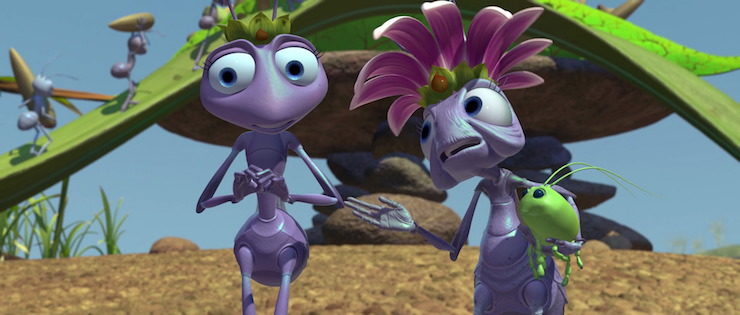
Granted, A Bug’s Life thankfully avoids the weird, slightly off-putting humans of Toy Story by simply not including humans at all, while also having several of the customary Pixar touches: sharply defined blades of grass that move individually in the wind, background art filled with various jokes (including one Hidden Mickey) and fine detail. The animation work for Gypsy is also beautiful, and the initial circus performance scenes are great. As are the “outtakes” that play during the closing credits.
But against this are many other problems: water that simply does not look like water (looking worse, in fact, than the water in The Little Mermaid, a hand-animated film released a full decade earlier), bugs that do not look like bugs, but do not exactly look cute and cuddly either, and moments where the various bugs move distinctly unnaturally.
Initially, audiences didn’t seem to care. A Bug’s Life pulled in a more than respectable $363.3 million at the box office, below Toy Story, but well ahead of Antz, which brought in $171.8 million, as well as the other film released by DreamWorks in 1998, The Prince of Egypt, at $218.6 million, and just beating out Disney’s own Mulan, at $304.3 million. Disney also licensed a video game, A Bug’s Life, and built a theme park attraction, It’s Tough to be a Bug!—a 3D film that, spoilers, also included some non-visual effects—for Disney’s Animal Kingdom, putting the film inside the park’s defining huge artificial tree, and for Disney’s California Adventure. Learning its lesson from the unexpected popularity of Toy Story, Disney also licensed some of the standard merchandising products—T-shirts, toys and mugs.
But slowly, all of this, except for the theme park attractions, vanished from Disney property, apart from a few mini plush toys (Heimlich and Flik) that still can be found online and in some theme park stores, and the occasional, hard to find Disney Trading Pin. In part, of course, this is because A Bug’s Life was released nearly twenty years ago, and unlike other Pixar films, never had a sequel. In part, this was because of the growing rift between Pixar and Disney that, as we’ll see, began in 1999 and continued through 2006, when Disney solved the problem by buying Pixar outright. Thanks to that rift, Disney had little incentive to push Pixar’s less popular products during this period, helping A Bug’s Life sink into comparative obscurity. In part, this was because Pixar had never really managed to solve the cuteness problem; small viewers happy to snatch up Buzz Lightyear toys were less excited about ant toys.

But some of this could also be said about other Disney and Pixar products that Disney continued to push aggressively, even as A Bug’s Life started to fall into comparative obscurity. In the end, I think A Bug’s Life largely vanished because, apart from the Pixar name, it has little else to distinguish itself from other computer animated films. Cute, but ultimately, ordinary. And Pixar was trying for the extraordinary. Or at least the very very good.
Toy Story 2, coming up next month.
Mari Ness lives in central Florida.










